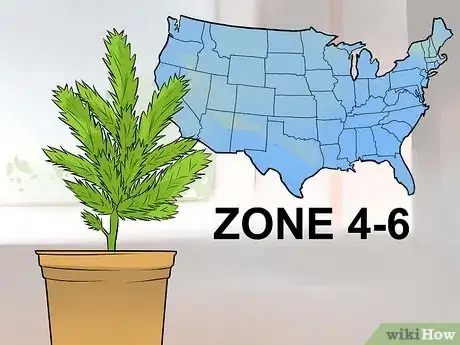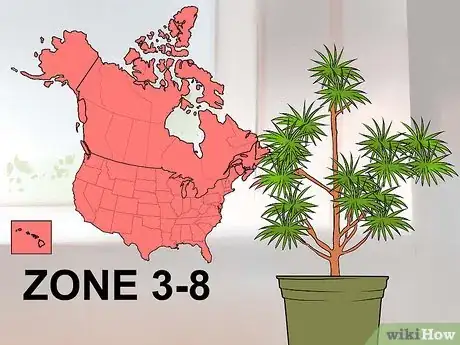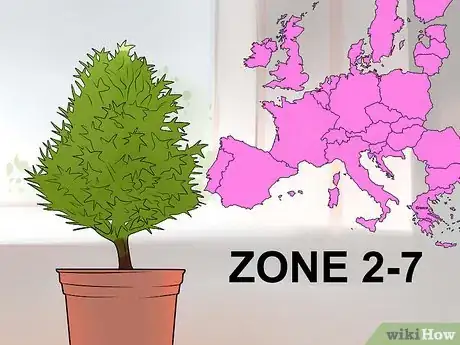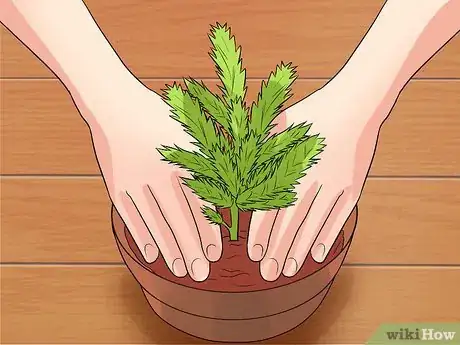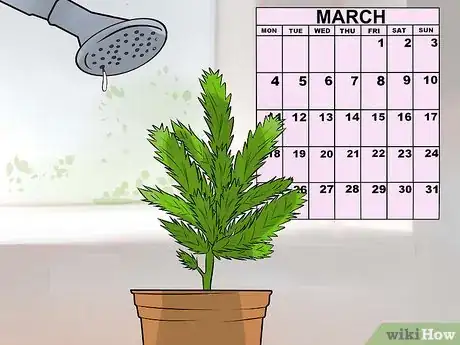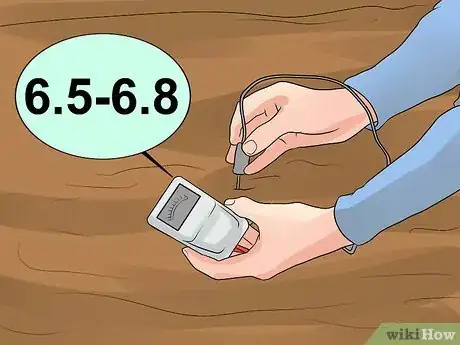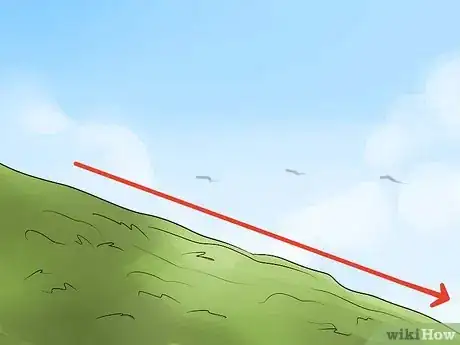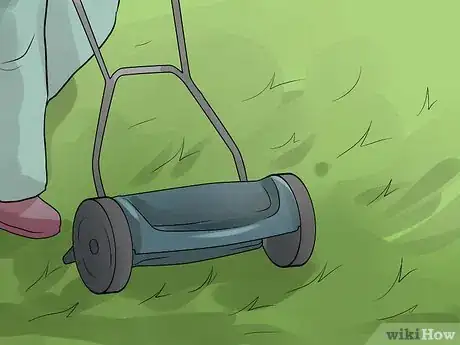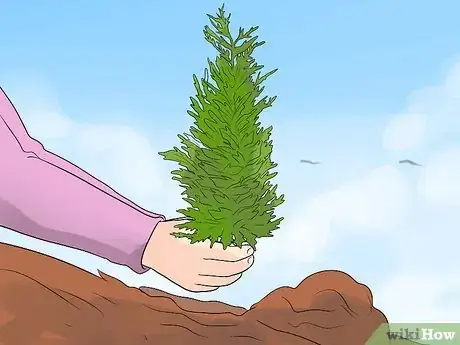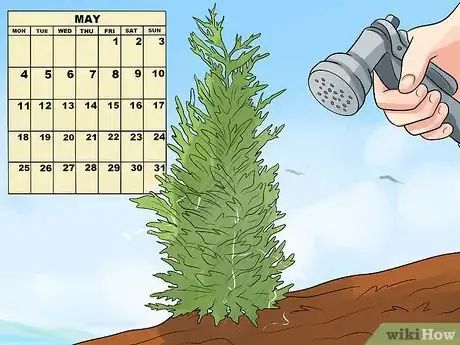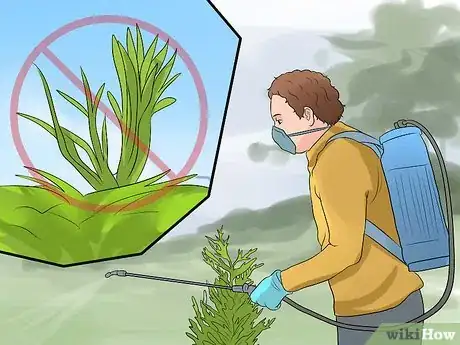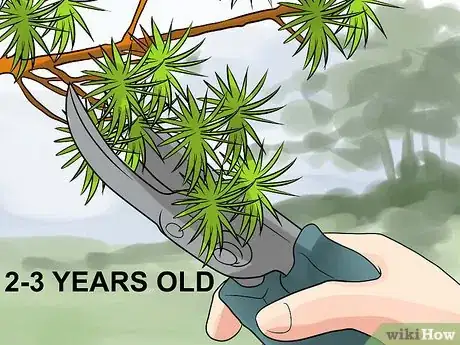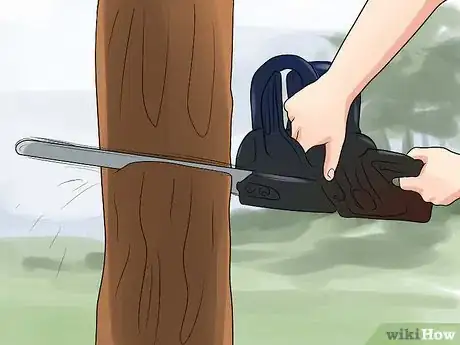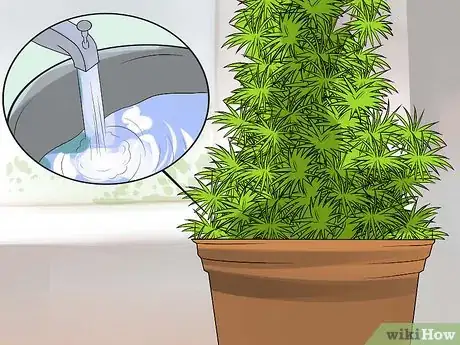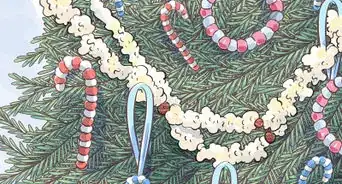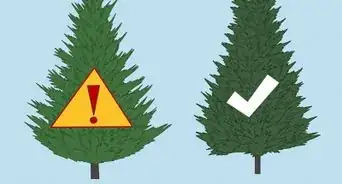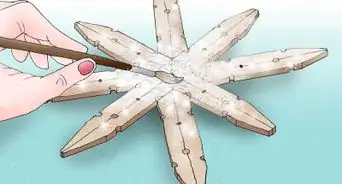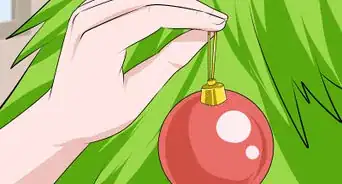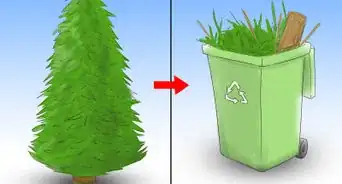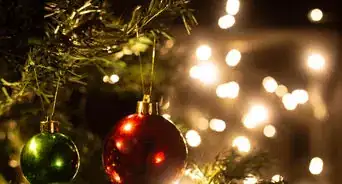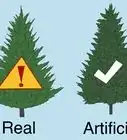This article was co-authored by Matt Bowman. Matt Bowman is a Gardener, Landscaper, the Owner of Georgia Farm to Table, and the Owner of Tradition Property Services in Atlanta, Georgia. With over 20 years experience, he specializes in organic gardening, landscape maintenance, handyman services, homecare services, and supplying Christmas trees. Matt earned a BA in Journalism from the University of Georgia.
This article has been viewed 183,599 times.
A Christmas tree can take a long time to grow - often over a decade. Growing your own Christmas tree can take time but in the end, you will have a greener and more fragrant tree than one purchased at a Christmas tree vendor. Planted Christmas trees are good for the wildlife around the planting site, keep the soil stable, and can be used as mulch once the holidays are over.[1]
Steps
Selecting and Starting Your Seedling
-
1Know when to choose a fir transplant. Firs are popular Christmas trees, as they have a fragrant scent, rich coloring and retain their needles well. Firs grow best on northern or eastern slopes in areas that have cooler climates or higher elevation. There are several types of firs, all with their applicable zone growth areas.[2] Firs also tend to hold up better in the home, whereas pines and spruces often dry out faster.[3]
- Fraser Fir: Found in the Appalachians Mountains at high elevations (zones 4-7)
- Douglas Fir: The most popular Christmas tree species in the U.S. (zones 4-6)
- Concolor Fir: Also known as the White Fir (zones 4-7)
- Balsam Fir: This is the best fir for colder climates (zones 3-6)
- Noble Fir: This is the largest native fir in North America (zones 4-5)
-
2Go for a pine seedling. Pines tend to grow quickly and can reach a height of 6 to 7 feet within six years as long as they have good growing conditions. They grow best on southern or western slopes. There are several types of pines, including:[4]
- White Pine: This is the tallest native pine species in North America (zones 3-8)
- Virginia Pine: This pine does well in poor soil and has sharp cones (zones 4-8)
- Scotch Pine: This pine has a high reseeding ability and can thrive in poor soil (zone 3-7)
- Sand Pine: This pine is ideal for hot climates (zones 7-10)
Advertisement -
3Consider a spruce transplant. Spruce trees are bright and colorful, but they have prickly needles and tend to lose their needles after a week or two once they are harvested. Spruces grow well on northern or eastern slopes in areas with cooler climates. There are two main types of spruce:[5]
- Norway Spruce: This spruce can be found throughout North America but is native to Europe (zones 2-7)
- Colorado Blue Spruce: This spruce type is known for its blue-green needles (zone 4 to 7a)
-
4Go for a Leyland cypress. A non-traditional tree species like the Leyland cypress can create a unique Christmas tree for your home. Leyland cypresses also require very little shaping and can reach 6 to 7 feet tall in four years.[6]
-
5Grow the seedling in a pot first. To grow a Christmas tree successfully in the ground, you will need to plant the seedling in a pot in a greenhouse. You can also buy a young seedling at a tree nursery. You will then transplant the tree to the planting site so it grow tall and strong in the ground. You usually want a 2-2 ratio for a tree, which means it spent two years in a seedbed and two years in a transplant.[7]
- You will need to plant the seedling in a potting mixture in a pot. The potting mixture should be made of equal parts peat, vermiculite, and perlite. Add 1/4 tsp lime per gallon of potting mixture but make sure the pH of the soil is around 7(or neutral). Once the seedling is in the mixture, add fertilizer to the mixture to help the seedling grow.
- You will also need a fluorescent lamp to heat the seeds. Use a white bulb made for plants so you do not burn the plants with the light.
-
6Care for the seedling until it is ready for the planting site. Christmas tree species do not need a lot of water after their first year of growth. Make sure you water the seedling from late spring to early fall once a week during its first year of growth.[8]
- 2-2 transplants are best for spruce and fir seedlings. This means the seedling spends two years in a seedbed and two years in the transplant site. 2-0, where the seedling grows for two years in a seedbed, is best for pine seedlings.
Preparing the Planting Site
-
1Get the soil tested. The first step in preparing the planting site is to get the soil tested. You need soil that drains well and that does not contain heavy clay. The soil test will dictate if the site is good for a specific seedling.[9]
- The soil test will also give you a pH for the soil. Some species do well in certain soil pHs, such as Fraser firs, which grow best in well-drained soil with a pH of 6.5 to 6.8.
-
2Make sure the planting site has a slope. Christmas tree species do not do well with wet feet or excess moisture in the soil. Having a planting site with a 5% to 20% slope will ensure there is good water drainage and good air for growth.[10]
- You should also ensure the site gets full sun. Some seedling types, such as pines, grow well on south and west slopes. Spruces and firs do well on north and east slopes.
-
3Mow the area before planting. Prepare the soil for the seedling by removing any existing vegetation with a mower.[11]
- You may also need to take out any stumps or rocks in the soil with a pickaxe or a shovel. The planting site should be smooth, with no excess vegetation, stumps, or rocks.
-
4Plant the transplant seedling on the planting site. Once the planting site is ready, you can plant the transplant seedling on the planting site. Hand plant the seedling using a shovel or an auger.[12] [13]
- Dig a hole that is the same depth as the hole the seedling was grown in at the nursery or in the greenhouse. To determine the correct depth, check the trunk of the tree for a noticeable color shift, as this will make the surface level where the seedling was originally grown.
- Place the seedling in the hole and spread the roots carefully and gently. Avoid twisting or screwing the seedling into the hole as this will tangle up the roots, which can kill the tree. Cover up the hole with soil. Give the tree a good watering after the planting.
- If you are planting more than one transplant seedling at a time, make sure the trees are planted in rows eight feet apart, with seven to eight feet between each seedling. This will ensure the trees are not at risk of disease or pest issues.
Cultivating and Harvesting the Tree
-
1Water the tree during the dry months or during a drought. Christmas trees require relatively low maintenance after the first year of growth. After the first year of growth, the tree will become established and only require watering during dry months or drought.
-
2Maintain the planting site so there are no weeds or grasses. You will need to use a mower to remove any weeds around the tree. You will also need to do careful weed-eating techniques around the trees. Weeds and grasses around the tree can starve the tree of water and nutrients.[14]
- You may want to invest in a weed-killing solution to spread on the soil around the tree. You can use organic weed killers or chemical pesticides.
-
3Prune and shear the tree when the needles are ¾-1 inch (1.9cm-2.5cm) long. Pruning and shearing the tree is very important. Do this every year, around mid-summer, after the tree has flushed out its new growth.[15]
- Use pruners or garden shears to shape the tree. Remove any imperfections, such as double tops and any misshapen branches.
- You should limit any pruning during the year you are planning to harvest the tree, as you want to avoid any visible cuts to the exterior branches of the tree.
-
4Check if the tree sheds its needles excessively. It is normal for Christmas tree species to shed their needles, usually about 30 percent of their needles every year. But if you notice excessive needle shedding or yellowing needles, these may be signs of a disease or a pest issue.[16]
- You will then need to take steps to eliminate pests that are eating the tree or treat diseases on the tree before you harvest the tree, as you do not want these pests to kill the tree or to enter your home once the tree is harvested. Though it is rare for pests to appear on Christmas trees species, it can happen. The most common pests found on Christmas tree species are the Cinara aphid, the spruce spider mite, and the praying mantis.[17]
-
5Harvest the tree within six to nine years. Trees like firs and spruces grow about 1 ft (0.30 m) a year, so it takes about 6-10 years to grow a tree that's around 6–8 ft (1.8–2.4 m) tall.[18] You can harvest the tree by cutting it down with a chainsaw or a handsaw.[19]
- For more information on how to cut down or fell a tree, see: How to Fell a Tree
- If you're interested in replanting the tree after the holiday season, keep its root ball intact by digging up the tree, rather than cutting it.[20]
-
6Cut the tree down during the late fall. You should cut the tree when it is full of moisture, usually during the late fall, so the needles stay green and supple when the tree is displayed indoors.[21]EXPERT TIPMaggie Moran is a Professional Gardener in Pennsylvania.Home & Garden Specialist

 Maggie Moran
Maggie Moran
Home & Garden SpecialistKeep in mind that you can’t replant your tree after harvest. Horticulturalist Maggie Moran says, “Christmas trees are typically cut down rather than dug up. Unfortunately, replanting a tree without roots isn't possible.”
-
7Place the tree in a container with water as soon as it is cut. Make sure you place the tree in water once it is cut to prevent the cut from resealing. If the cut reseals, the tree will not be able to take in water and may not have a very long lifespan.[22]
- You can also harvest the tree early, before Christmas, and then cut a thin slice off the trunk and stick it in water when you are ready to display it for Christmas.
- Make sure you regularly water the tree during the Christmas season, as well.
Expert Q&A
-
QuestionShould I choose spruce, fir, or pine for a Christmas tree?
 Matt BowmanMatt Bowman is a Gardener, Landscaper, the Owner of Georgia Farm to Table, and the Owner of Tradition Property Services in Atlanta, Georgia. With over 20 years experience, he specializes in organic gardening, landscape maintenance, handyman services, homecare services, and supplying Christmas trees. Matt earned a BA in Journalism from the University of Georgia.
Matt BowmanMatt Bowman is a Gardener, Landscaper, the Owner of Georgia Farm to Table, and the Owner of Tradition Property Services in Atlanta, Georgia. With over 20 years experience, he specializes in organic gardening, landscape maintenance, handyman services, homecare services, and supplying Christmas trees. Matt earned a BA in Journalism from the University of Georgia.
Gardener & Owner, Tradition Market & Garden
-
QuestionHow long does it take to grow a Christmas tree?
 Maggie MoranMaggie Moran is a Professional Gardener in Pennsylvania.
Maggie MoranMaggie Moran is a Professional Gardener in Pennsylvania.
Home & Garden Specialist It takes nearly 10 years to grow a tree from a seed to a size suitable for cutting.
It takes nearly 10 years to grow a tree from a seed to a size suitable for cutting. -
QuestionCan you plant a Christmas tree after using it?
 Maggie MoranMaggie Moran is a Professional Gardener in Pennsylvania.
Maggie MoranMaggie Moran is a Professional Gardener in Pennsylvania.
Home & Garden Specialist Unfortunately, no. Replanting a tree without roots isn't possible and Christmas trees are typically cut down rather than dug up.
Unfortunately, no. Replanting a tree without roots isn't possible and Christmas trees are typically cut down rather than dug up.
References
- ↑ http://www.livingthecountrylife.com/gardening/trees/grow-your-own-christmas-trees/
- ↑ http://www.hobbyfarms.com/crops-and-gardening/growing-your-own-christmas-tree.aspx
- ↑ Matt Bowman. Gardener & Owner, Tradition Market & Garden. Expert Interview. 21 April 2020.
- ↑ http://www.hobbyfarms.com/crops-and-gardening/growing-your-own-christmas-tree.aspx
- ↑ http://www.hobbyfarms.com/crops-and-gardening/growing-your-own-christmas-tree.aspx
- ↑ http://www.hobbyfarms.com/crops-and-gardening/growing-your-own-christmas-tree.aspx
- ↑ http://www.hobbyfarms.com/crops-and-gardening/growing-your-own-christmas-tree.aspx
- ↑ http://www.hobbyfarms.com/crops-and-gardening/growing-your-own-christmas-tree.aspx
- ↑ http://www.livingthecountrylife.com/gardening/trees/grow-your-own-christmas-trees/
- ↑ http://www.hobbyfarms.com/crops-and-gardening/growing-your-own-christmas-tree.aspx
- ↑ http://www.hobbyfarms.com/crops-and-gardening/growing-your-own-christmas-tree.aspx
- ↑ http://www.livingthecountrylife.com/gardening/trees/grow-your-own-christmas-trees/
- ↑ http://www.hobbyfarms.com/crops-and-gardening/growing-your-own-christmas-tree.aspx
- ↑ http://www.hobbyfarms.com/crops-and-gardening/growing-your-own-christmas-tree.aspx
- ↑ http://www.hobbyfarms.com/crops-and-gardening/growing-your-own-christmas-tree.aspx
- ↑ http://www.hobbyfarms.com/crops-and-gardening/growing-your-own-christmas-tree.aspx
- ↑ http://www.ncchristmastrees.com/images/pdfs/PostHarvestPests.pdf
- ↑ Matt Bowman. Gardener & Owner, Tradition Market & Garden. Expert Interview. 21 April 2020.
- ↑ http://www.hobbyfarms.com/crops-and-gardening/growing-your-own-christmas-tree.aspx
- ↑ Matt Bowman. Gardener & Owner, Tradition Market & Garden. Expert Interview. 21 April 2020.
- ↑ http://www.livingthecountrylife.com/gardening/trees/grow-your-own-christmas-trees/
- ↑ http://www.hobbyfarms.com/crops-and-gardening/growing-your-own-christmas-tree.aspx
About This Article
To grow your own Christmas tree, start by researching your plant hardiness zone so you know which kind of tree to grow. For instance, if you live in zones 4-6, a fir tree is a good choice. Once you’ve picked your type of tree, start the seedling in a pot indoors. In addition to potting mix and fertilizer, you’ll also need a fluorescent lamp to warm the seeds and encourage them to start growing. Depending on the type of tree, you may need to grow the seedling for up to 2 years in a pot or seedbed before transferring it outside. Once you’re ready to plant the tree, look for an area with soil that drains well and isn’t too rich in clay. Most Christmas trees also prefer to grow on slopes rather than flat ground. Make sure to plant your tree in an area where it will get lots of sun. For expert advice on how to care for your tree after planting, scroll down!
